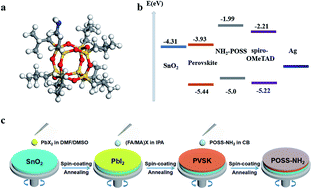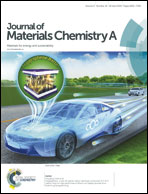Extremely low trap-state energy level perovskite solar cells passivated using NH2-POSS with improved efficiency and stability†
Abstract
Both efficiency and stability are two essential performance factors in hybrid halide perovskite solar cells, which are closely related to the ionic defects at the surface and grain boundary of the absorber films. To passivate these defects, we propose a derivative of polyhedral oligomeric silsesquioxane with an amino-group (NH2-POSS) to modify perovskite films. It successfully reduces the charge trap density and trap-state energy level (0.045 eV) as obtained by temperature-dependent admittance measurements, eventually leading to the enhancement of the open-circuit voltage (VOC) and power conversion efficiency (PCE) from 18.1% to 20.5% in the corresponding devices. Moreover, trap passivation also significantly enhances the stability of the devices, wherein the PCE of perovskite solar cells exhibits 20% degradation in a N2 atmosphere for 1000 h. The introduction of NH2-POSS suggests a feasible alternative solution for defect passivation to further improve both the efficiency and intrinsic stability of perovskite solar cells.



 Please wait while we load your content...
Please wait while we load your content...